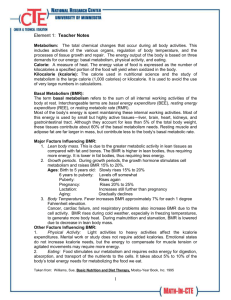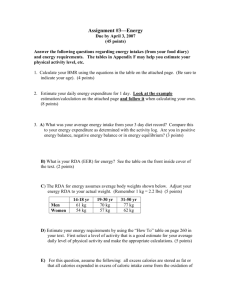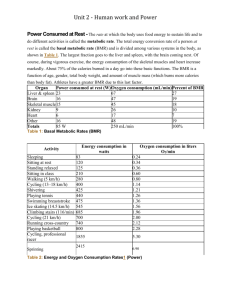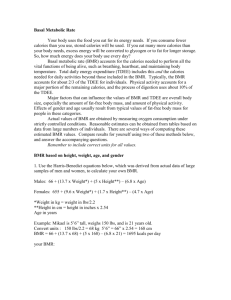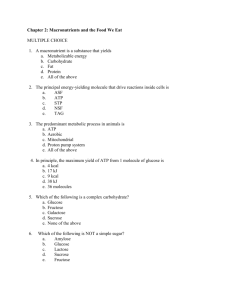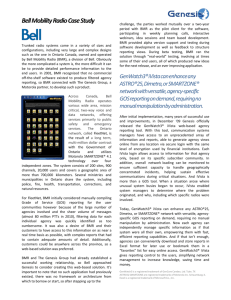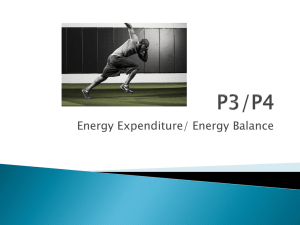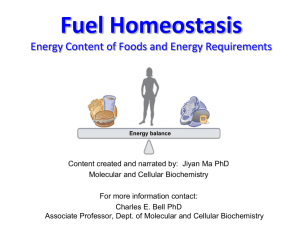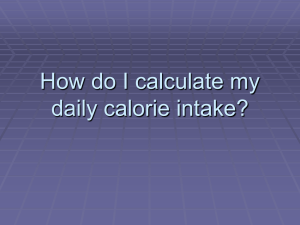Basal metabolism
advertisement
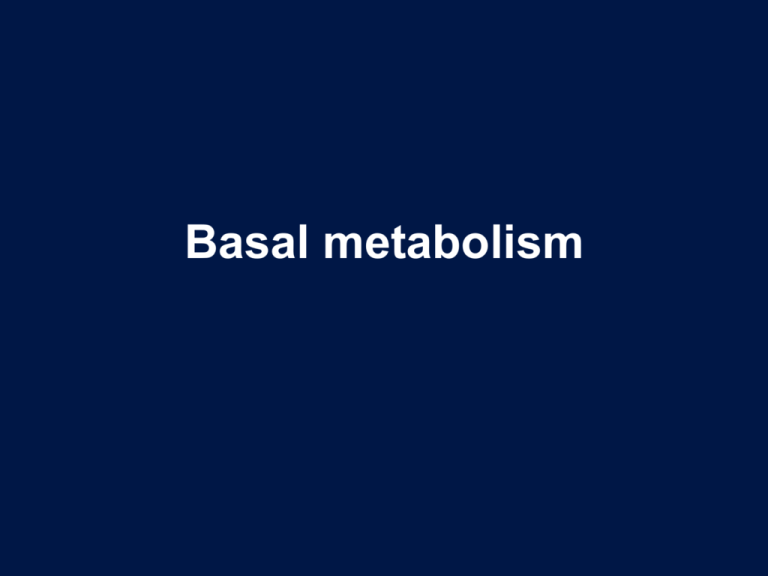
Basal metabolism
Introduction
• BMR – basal metabolic rate
• Minimal caloric necessity to ensure the
basic vital function in resting state
– Breathing, circulation, body temperature
– The amount of energy [calories, jouls], which
a man uses if he lay down whole day
• 70% of daily energy expenditure
– Depends on several conditions
Basal metabolism
• The amount of energy which is needed to
ensure the basic functions during basal
conditions:
–
–
–
–
Awakened, psychic and physical rest
Postabsorbtive time – SDE of food
Termoneutral zone - 18-22 °C
Body normal temperature
Influence on basal metabolism
•
•
•
•
Genetic factors
Gender
Age
Body weight
– % of fat
•
•
•
•
•
Body surface
Diet
Body temperature
Hormons
Exercise and physical activity
How to count basal metabolism
•
•
•
•
•
William McArdle a Frank Katch
Total daily energy expenditure (TDEE)
Women - 2000-2100 calories/day
Men - 2700-2900 calories/day
Athletes – up to 6000 calories/day
• Several methods
– Quick, Harris-Benedict equation,Katch-McArdle
equation, calorimetric methods (direct, indirect)
Quick method
•
•
•
•
•
Fast method based only on body weight
Lose weight = 22 - 26 kcal/kg
Basal (TDEE) = 30- 32 kcal/kg
Gain weight: = 36- 40 kcal/kg
Inaccurate in extreme values
Equations based on factors
• BMR
– State when all necessary vital functions are
ensured – such is circulation, breathing,
digesting, formation of new cells, etc.
– It considers age, gender, weight, height x
– x factor of physical activity =
– = TDEE
• total daily energy expenditure
Harris-Benedict equation (BMR based on
total body weight)
• Men: BMR = 66 + (13.7 x weight [kg]) +
(5 x height [cm]) - (6.8 x age [years])
• Women: BMR = 655 + (9.6 x weight [kg])
+ (1.8 x height [cm]) - (4.7 x age [years])
• x factor of physical activity
Factor of physical activity
• Sitting = BMR x 1.2
– (little or none work)
• Light = BMR x 1.375
– (light work or sport 1-3 days/week)
• Medium/Moderate = BMR x 1.55
– (3-5 days/week)
• Heavy = BMR x 1.725
– (6-7 days/week)
• Extreme = BMR x 1.9 (heavy daily work/sport –
exercise e.g. 2 times a day,maraton,
competition)
BEE Correction Factors for Physical Activity and Clinical Status
Physical activity
Factor
Clinical state
Factor
Resting in bed
1.2
Febrility
Resting out of bed
Tremor
Quadruparesis
1.3
1.3
0.8
Elective surgery
Peritonitis
Trauma of soft tissues
1.0-1.1
Paralysis
0.9
Multiple fracture
Closed wound of
smooth muscles
sepsis/heavy infection
1.2-1.4
Cancer
COPD
Burns
1.1-1.3
AIDS
1.5-1.8
Hemiparesis
1.2-1.3
1.0 + 0.13/°C
1.2-1.5
1.1-1.4
1.5-1.8
1.4-1.8
1.2-1.3
1.5-2.0
Example
• Women, 30 years, 167,5cm, 54,5kg
• BMR = 655 + (9.6 x 54,5 kg) +
(1.8 x 167,5 cm) - (4.7 x 30 years)
= 655 + 523 + 302 - 141
= 1339 kcal/day
• 1,2 x 1339 = 1606,8 kcal/day
Katch-McArdle equation (BMR based on
net weight)
• BMR (men and women) = 370 + (21,6 x
net weight [kg])
• Net weight = muscle weight
Example
• Women, 54,5 kg, 20% fat
– Net weight is 43,6 kg
• BMR = 370 + (21,6 X 43,6)
= 1312 kcal
• Factor of physical activity - 1,2
TDEE = 1,2 x 1312 = 1574 kcal
Indirect calorimetry – metabolic
consumption
• One of the most accurate methods
• REE
– resting energy expenditure
– Measures the energy expenditure when resting –
basal metabolism
– Consumption of O2 vs. expense of CO2
REE (kcal/day) = [3,9 (VO2) + 1,1 (VCO2)] x 1,44
• VO2 = oxygen consumption [mL/min]
• VCO2 = expense of carbon dioxide [mL/min]
Fick equation
• The most accurate method, used in ICU patients
– The need for Swan catheter to arteria pulmonalis
• CaO2 - CvO2 = 1,39 x Hb(g/dL) x (SaO2 - SvO2)
– CaO2 and CvO2 – content of oxygen in arterial and venous
blood [ml/dl]
– SaO2 and SvO2 – saturation with oxygen in arterial
and venous blood [fraction...%]
• VO2 = [(CaO2 - CvO2)] x 10 x SV [L/min]
• VO2 [mL/min] x 7 = 24 hod energy expenditure
[kcal/day]
Example
• Women, wiht Hb 10,5 g/dL, SataO2 96%, SatvO2
65%, heart rate 70 bpm, stroke volume 70ml
• CaO2 - CvO2 = 1,39 x Hb (g/dL) x (SaO2 - SvO2)
– CaO2 - CvO2 = 1,39 x 10,5 x (0,96 – 0, 65)
= 4,52 mL/dL
• VO2 = [(CaO2 - CvO2)] x 10 x SV [L/min]
– 4,52 x 10 x 4,9
= 221,48 mL/min
• VO2 [mL/min] x 7
– 221,48 x 7
= 1550,36 kcal/24 hrs
Energy metabolism
• The amount of energy consumed in a unit of time
[kJ, kcal/24hrs]
• Direct calorimetry {measuring heat production}
– Energetic value of food = combustible heat is the amount
of heat released after 1g of substance is burnt
• Indrect calorimetry {O2,CO2}
– Closed method of Krogh metabolimeter
– Opened method of Douglas analysis of O2,CO2 in
expired air
• Energetic equivalent of O2 [EE] is the amount of energy,
which is released when 1 L of O2 is consumed. It depednd on
the type of oxiding nutritients
• Respiratory quotient RQ = VCO2/VO2
• 1kcal = 4,185 kJ
Practicals
• Basal metabolism
